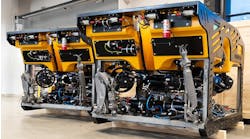Converted vessel set to drill in record water depth
Marshall DeLuca
Business EditorWilliam Furlow
Technology Editor
- The Hughes Glomar Explorer - 1973 [56,343 bytes]
- The Glomar Explorer - 1998 [18,343 bytes]
- The Glomar Explorer under conversion at Hunters Point Naval Shipyard, San Fransisco. [28,345 bytes]
Global Marine has signed a 30-year lease with the US Navy for use of the vessel in drilling for oil and gas in ultra-deepwater depths. The vessel has just completed a 15-months-long conversion from heavy lift to drilling and will go to work this month in the US Gulf of Mexico.
The history of the "drillship" Glomar Explorer is shrouded in controversy and steeped in intrigue. The vessel was built for a top-secret mission known to the CIA as the "Jennifer Project". The Jennifer Project began in February 1968 when a Russian (then USSR) "Golf"-class submarine left its port in Validivostok, Russia for a destination in the Pacific Ocean.
The Russian submarine was an older, diesel-engined craft, with an exaggerated large "fin" equipped with a superior SS-N-5 missile system. The SS-N-5 missile system allowed the submarine to fire a 1-megaton nuclear warhead from a submerged position, at a target 700 miles away.
Because the sub was a known missile carrier, the US Navy began tracking its journey through a sophisticated subsea surveillance network. During the journey, however, the sub experienced an explosion and sank to the bottom of the Pacific Ocean northeast of the Hawaiian Islands. The water depth at the site was about three miles.
Through listening devices, the US Navy tracked the sinking of the submarine, then waited to see if a recovery attempt would be made by the the USSR. When no attempt was made, the US Central Intelligence Agency (CIA) mobilized a top-secret recovery mission fueled by hopes of recovering USSR military secrets.
Jennifer Project
The project was controversial and problematic from the onset. The fact that the sub was located in international waters caused immediate concern from legal and diplomatic standpoints. At the time of the incident, there were no clear precedents for control of international waters, nor salvaging of another government's equipment. However, at the end of World War II, the Soviets recovered a number of German U-boats with no regard to legal standings. On this basis, the Jennifer Project was given the legal go-ahead.A vessel was needed to retrieve the 1,700-ton submarine from the three-mile depth, and a cover story needed to be concocted to ensure secrecy of the pursuit. The US government, through Hughes Tool Company, hired Global Marine Drilling to design the ship and Howard Hughes and his Hughes Tool Company to develop the lift system.
The government decided on a cover story stating that the Hughes Tool Company, acting on its own, had launched a project of deepsea mining for naturally-occurring copper and nickel nodules. This was leaked to the press. The employment of Howard Hughes and Hughes Tool added credibility to the story.
The result was the Hughes Glomar Explorer, constructed by Sun Shipbuilding & Drydock in Chester, Pennsylvania. Vessel construction began in April 1972 and launching took place in November 1972. The vessel measured 618 ft in length by 115 ft in width and carried a crew of 172 men. The most significant features of the vessel were the heavy-lift grappling "claw" suspended under the squat mast and an oversized moon pool, into which the grapples fit.
The grappling claw system that attached to drill string was capable of reaching 17,000 ft depths. A machine similar to an iron roughneck was used to makeup and breakout the drill string for lowering and raising the claw. Once the claw reached the submarine, it was closed via a remote hydraulic system and raised using the drawworks. The heavy lift system could accommodate weights up to 4,250 tons.
The sub weighed 1,700 tons. The over-sized 199 ft by 74 ft moonpool with retractable doors was designed to hold the three sections of the sub out of view. The vessel also contained docking legs, similar to those used on jackups, that could dock loads below the vessel, allowing for a transfer of weight from the derrick system to the docking legs.
The submarine lift
The Hughes Glomar Explorer arrived over the presumed wreckage site on July 4, 1974. A sophisticated dynamic positioning system was employed to establish an exact position for the operation. The crew then began lowering the drillstring and claw to the seafloor.First contact was made on the fourth day after the start of the operation. The first section of the sub was raised to the moon pool. The system was lowered again to recover the other two pieces.
US government crews then disassembled the submarine wreckage and examined USSR Soviet technology. Sources reported later that nothing of value was recovered, not even nuclear-tipped missiles, code books, or a journal detailing the training of nuclear weapons experts.
After 40 days on the site, the vessel set sail for the Island of Maui on August 12, 1974. The vessel stayed a short time in Hawaii and then returned to the US Naval Station in Suisan Bay, California. Without another task, the vessel was then "mothballed" in 1978 and made part of the US Naval Reserve Fleet.
During the period it was mothballed, the US Government attempted to sell the vessel to other branches of the government and then to the public, but without success. During this period, Global Marine did operate the vessel from 1978-1980 for legitimate deep-ocean mining tests in water depths up to 17,000 ft. Commercial quantities of nodules were recovered in these tests, but the technology was not explored further because deepwater mineral mining did not offer an adequate return on investment.
The vessel continued to lay idle in the yard as part of the US Naval Reserve Fleet until August 1996 when Global Marine signed a 30-year lease with the government for use of the ship for deepwater drilling. Shortly after, a five-year contract was signed with Chevron and Texaco for exploratory drilling in the US Gulf of Mexico.
The conversion
In November 1996 Global Marine took possession of the vessel and began the first phase of conversion to an ultra-deepwater drillship capable of drilling in 10,000 ft water depths at the Hunters Point Naval Shipyard in San Francisco, California. This stage of the conversion included removal of existing equipment and structures, such as the docking legs, the lifting device, and the derrick system.The vessel was next moved to Cascade General drydock in Portland, Oregon in February 1997. At Cascade, the moon pool was partially filled with new hull steel to allow for additional storage space for riser and mud systems and an additional moon pool was created to deploy the ROV equipment.
In September 1997, the Glomar Explorer was moved to the Atlantic Marine Shipyard in Mobile, Alabama for the final phase of the conversion. Atlantic Marine installed a 2 million lb capacity derrick with a motion compensator to maintain constant weight on bit, despite vertical motion of the vessel, and a top drive drilling system.
A horizontal drill pipe racking system capable of handling 30,000 ft of pipe was also installed along with a riser handling system. The ship also received a dynamic positioning upgrade with four new thrusters. The Glomar Explorer was officially christened on January 30, 1998 as the world's largest drillship on time and under budget.
Global Marine has signed a five-year, $260 million contract with Chevron and Texaco for the Glomar Explorer. The ship will operate first for Chevron on Atwater 119 in the Gulf of Mexico. It will be drilling in a record 7,716 ft of water (surpassing the Baha prospect in 7,612 ft of water). Then, the vessel will be turned over to Texaco after completion of the first well and will rotate between the two companies, one well at a time. The vessel was scheduled to arrive on location in March.
The contract
Global Marine has a 30-year lease for the Glomar Explorer from the US Navy for an unreleased amount of money. The ship required a very expensive three-stage refit before contracting out to Texaco and Chevron for drilling in the deepwater Gulf. The cost of the conversion alone was over $160 million. Global Marine's CFO, Gary Kott, puts the total cost at around $200 million, which is close to the estimated price of a new build for operations in ultra-deepwater.The original ship cost the government about $130 million, according to author Clyde W. Burleson, who wrote a history of the vessel entitled "The Jennifer Project." While these amounts were in 1976 dollars, it is ironic that the conversion of the vessel would exceed its original purchase price.
The cost of the massive overhaul of the 619-ft ship is only one of the ironies. In many cases, state-of-the-art technology stands side by side with the ships original controls. On the bridge, for example, the original helm, looking like a carefully maintained antique in chrome and polished wood, is literally five ft from a bank of full color DPS computers that appear to belong on the bridge of a fictional spaceship.
The original design contractor for the vessel, Global, left in place the systems that still functioned at or above current standards, and added or up dated those that progress had improved upon. The drill floor features an iron roughneck, automated casing and pipe handling systems, and an air-conditioned command center.
When Global took possession of the ship in the fourth quarter of 1996, it was mothballed in the Naval Reserve Fleet in Suisun Bay, California. Actually, the future of the ship was almost as big a controversy as its primary purpose. There was quite a bit of red tape involved in leasing, selling or even scrapping the vessel, because it was financed by several departments of the government. It eventually went to the General Services Administration which offered it first to other government departments, then to state governments, then finally to the private sector. When there were no takers, the ship was mothballed.
The opportunity
Global Marine was in an ideal position to evaluate the economics and practicality of converting the ship for deepwater drilling. Kott said his company designed the ship for the government, so Global knew what it could do. Basically, the deal Global cut with the government was the leasing of the hull, which Kott said is the most attractive part of the ship from a deepwater conversion standpoint because it was specifically designed for point loading over the moon pool.By contrast, tankers, which are often considered for conversions, are designed for uniform loading and have scantlings uniformly distributed through out the hull. The Glomar Explorer was specifically designed to take on an enormous point load and has a higher fatigue life than most ships.
Kott said the vessel was a unique opportunity for the company and it would seek new build opportunities in the future to flesh out an ultra deepwater fleet. Other operators and contractors possibly overlooked the availability of the Glomar Explorer because of the assumed cost of conversion and other problems dealing with US government leasing.
By leasing and converting an existing vessel, Global had a one-time opportunity to get a head start in ultra-deepwater exploration, an area Kott said the company is very interested in. As part of the Global long-range strategy, Kott said the company is acquiring more floating vessels and is considering building two new drillships of its own, to balance out is plentiful fixed bottom MODU fleet.
References
Burleson, C. W., "The Jennifer Project," Texas A&M University Press (College Station, Texas), 1997.Copyright 1998 Oil & Gas Journal. All Rights Reserved.


